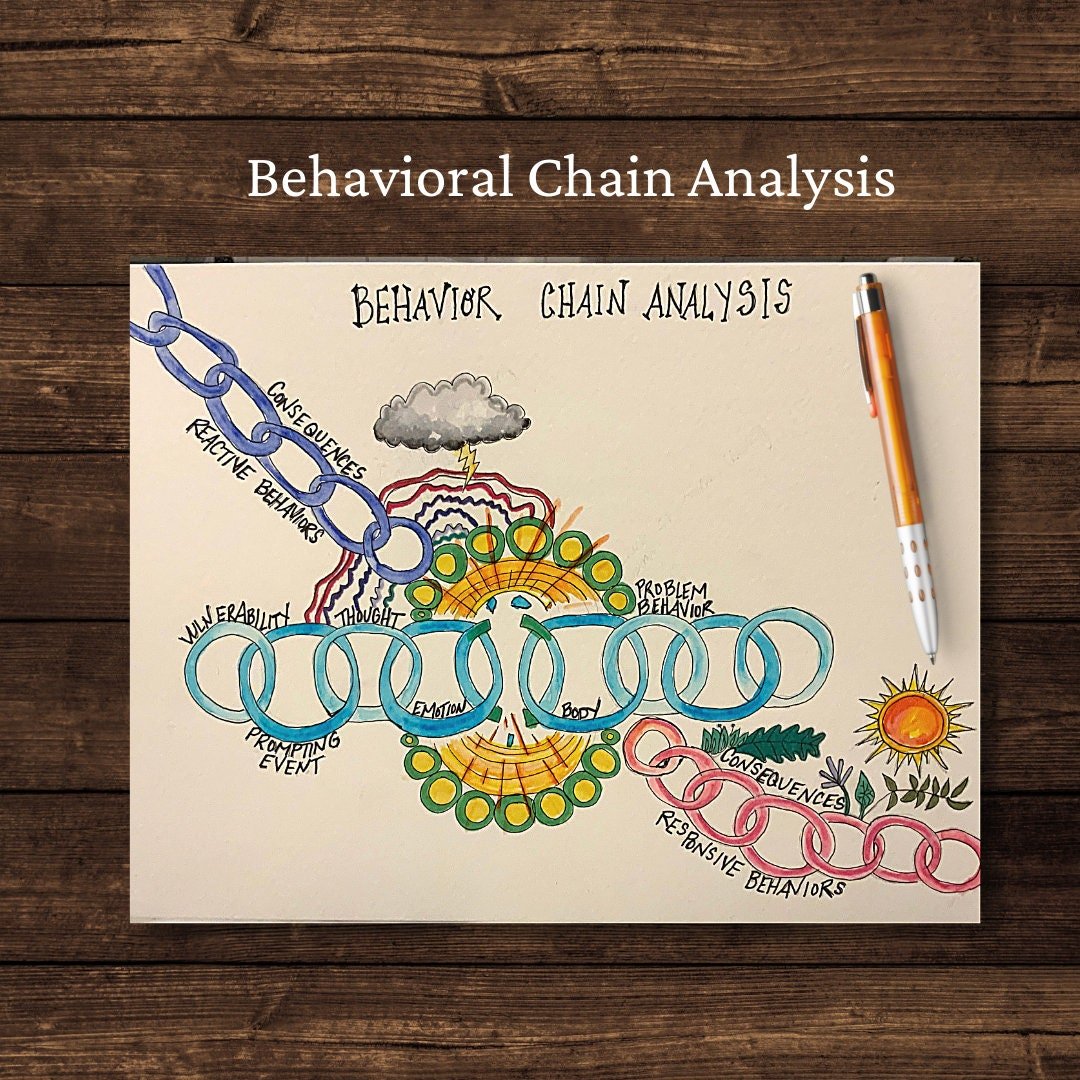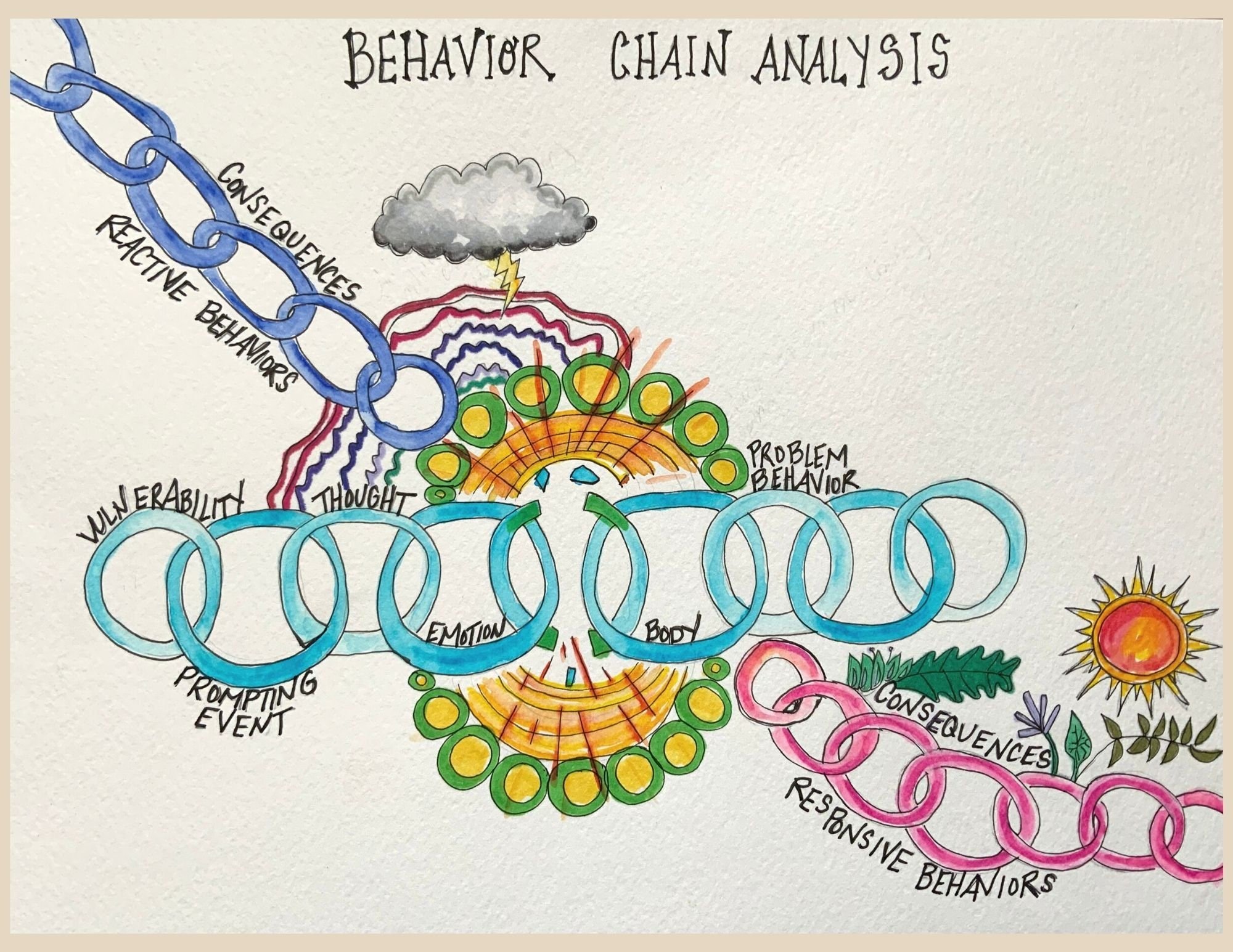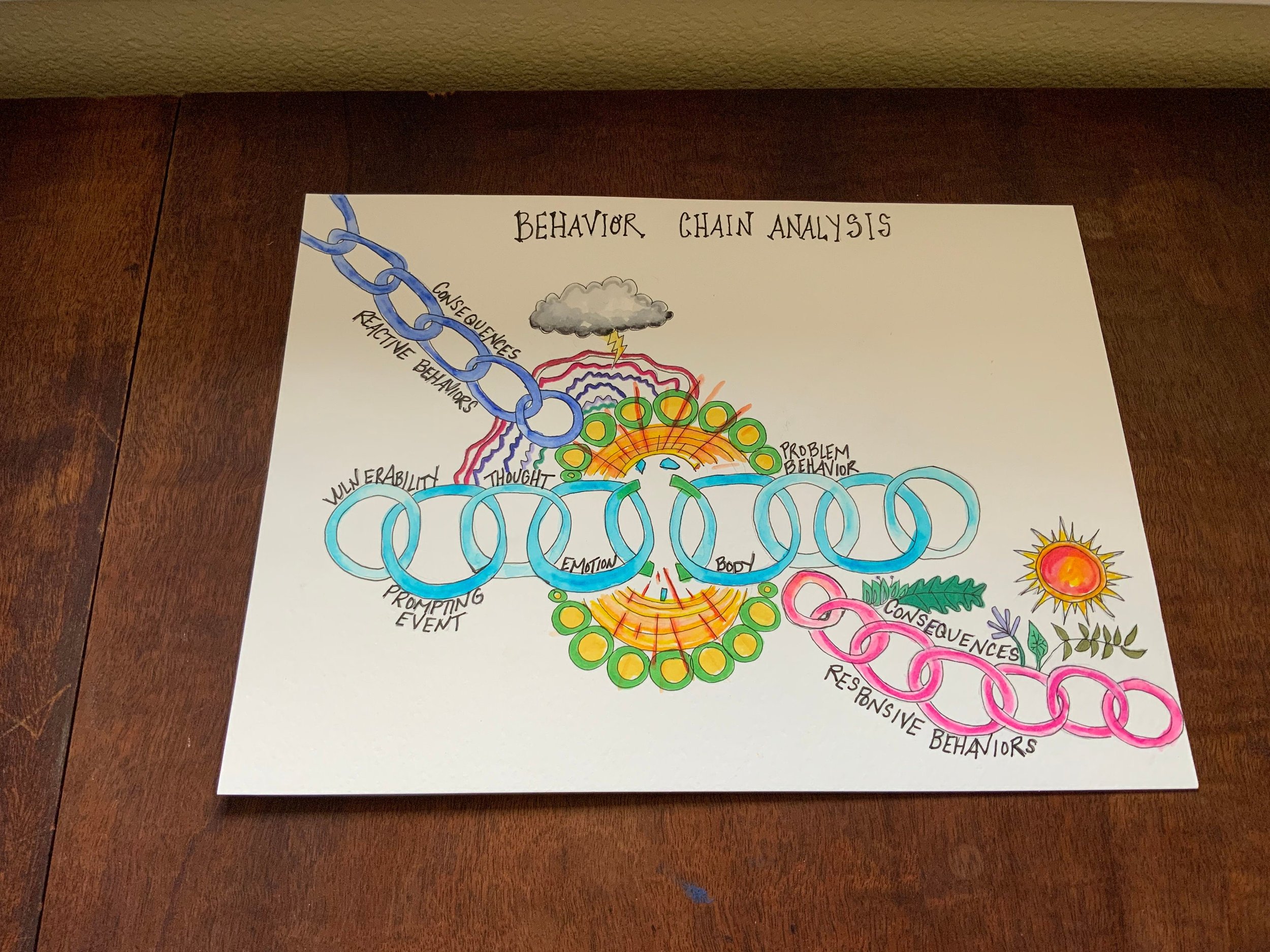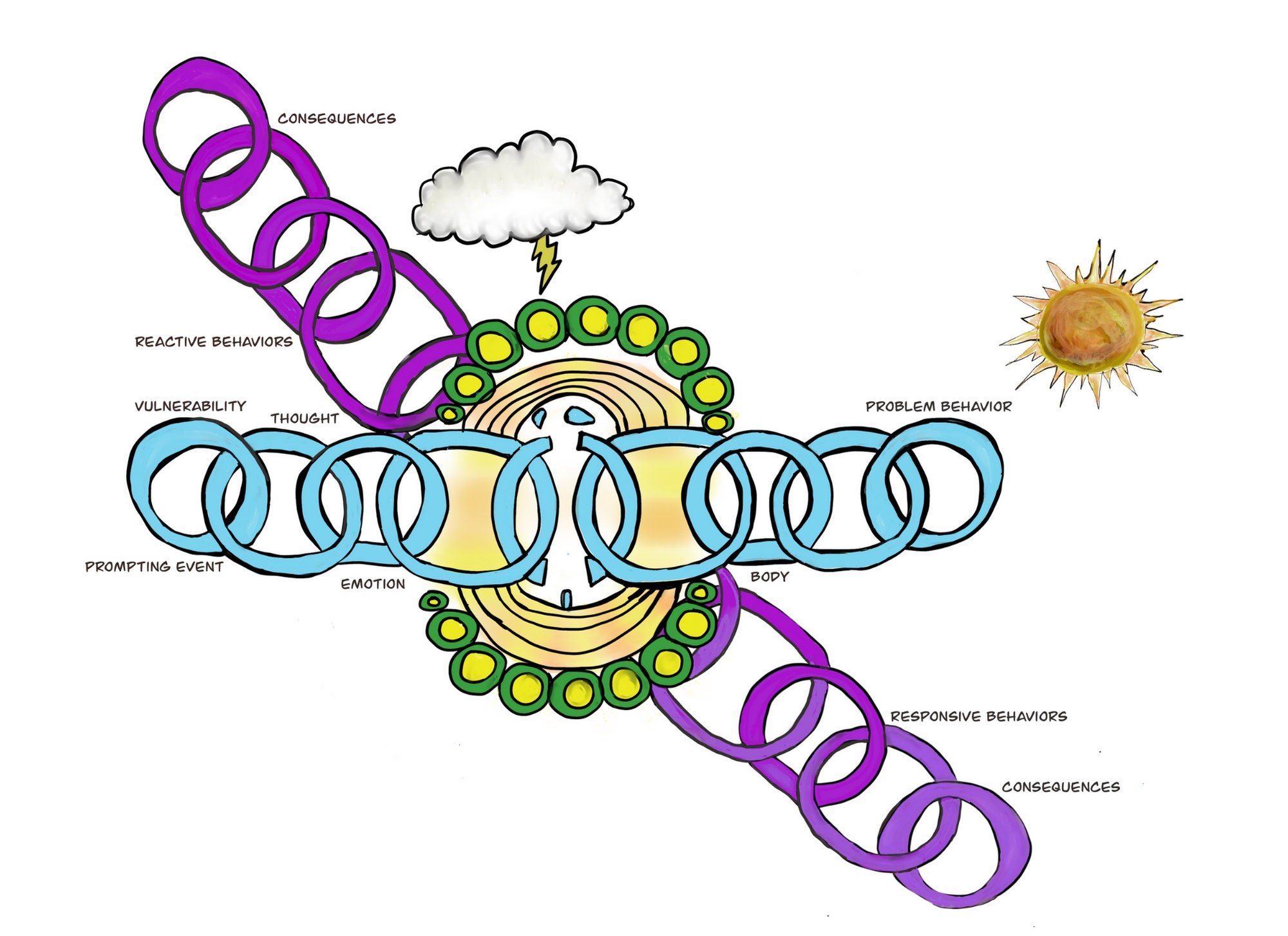Behavior Chain Analysis
$3.00
A chain analysis is a technique designed to help a person understand the function of a particular behavior.1 During a chain analysis of a particular problem behavior (for example, deliberate self-harm), a person tries to uncover all the factors that led up to that behavior.
In other words, a person tries to discover all the links in the chain that ultimately resulted in problem behavior. Therefore a chain analysis will help you figure out all the things that can contribute to problem behavior.
For example, a person may identify the situation he was in, the thoughts he was experiencing, or the feelings he was having just prior to engaging in that behavior. In doing so, a person can increase his awareness of all the factors that may put him at risk for problem behavior. This way a person has better ability to intervene early on to prevent that behavior in the future.
It can be helpful to go through a chain analysis soon after you engage in problem behavior. This way, your experience is fresh in your mind and you will likely be able to remember more information about the factors that led up to your problem behavior.
It might also be helpful to identify what things might have made you more susceptible to responding to the situation as you did. For example, when people do not eat well or do not get enough sleep, they may be more susceptible to experiencing negative moods or having more reactive emotional experiences.
After you go through the chain analysis, come up with different coping strategies you could use at each stage. In addition to identifying the function a problem behavior serves, it is also incredibly important to figure out how to "break the chain" through the use of healthier coping strategies.
In other words, a person tries to discover all the links in the chain that ultimately resulted in problem behavior. Therefore a chain analysis will help you figure out all the things that can contribute to problem behavior.
For example, a person may identify the situation he was in, the thoughts he was experiencing, or the feelings he was having just prior to engaging in that behavior. In doing so, a person can increase his awareness of all the factors that may put him at risk for problem behavior. This way a person has better ability to intervene early on to prevent that behavior in the future.
It can be helpful to go through a chain analysis soon after you engage in problem behavior. This way, your experience is fresh in your mind and you will likely be able to remember more information about the factors that led up to your problem behavior.
It might also be helpful to identify what things might have made you more susceptible to responding to the situation as you did. For example, when people do not eat well or do not get enough sleep, they may be more susceptible to experiencing negative moods or having more reactive emotional experiences.
After you go through the chain analysis, come up with different coping strategies you could use at each stage. In addition to identifying the function a problem behavior serves, it is also incredibly important to figure out how to "break the chain" through the use of healthier coping strategies.
A chain analysis is a technique designed to help a person understand the function of a particular behavior.1 During a chain analysis of a particular problem behavior (for example, deliberate self-harm), a person tries to uncover all the factors that led up to that behavior.
In other words, a person tries to discover all the links in the chain that ultimately resulted in problem behavior. Therefore a chain analysis will help you figure out all the things that can contribute to problem behavior.
For example, a person may identify the situation he was in, the thoughts he was experiencing, or the feelings he was having just prior to engaging in that behavior. In doing so, a person can increase his awareness of all the factors that may put him at risk for problem behavior. This way a person has better ability to intervene early on to prevent that behavior in the future.
It can be helpful to go through a chain analysis soon after you engage in problem behavior. This way, your experience is fresh in your mind and you will likely be able to remember more information about the factors that led up to your problem behavior.
It might also be helpful to identify what things might have made you more susceptible to responding to the situation as you did. For example, when people do not eat well or do not get enough sleep, they may be more susceptible to experiencing negative moods or having more reactive emotional experiences.
After you go through the chain analysis, come up with different coping strategies you could use at each stage. In addition to identifying the function a problem behavior serves, it is also incredibly important to figure out how to "break the chain" through the use of healthier coping strategies.
In other words, a person tries to discover all the links in the chain that ultimately resulted in problem behavior. Therefore a chain analysis will help you figure out all the things that can contribute to problem behavior.
For example, a person may identify the situation he was in, the thoughts he was experiencing, or the feelings he was having just prior to engaging in that behavior. In doing so, a person can increase his awareness of all the factors that may put him at risk for problem behavior. This way a person has better ability to intervene early on to prevent that behavior in the future.
It can be helpful to go through a chain analysis soon after you engage in problem behavior. This way, your experience is fresh in your mind and you will likely be able to remember more information about the factors that led up to your problem behavior.
It might also be helpful to identify what things might have made you more susceptible to responding to the situation as you did. For example, when people do not eat well or do not get enough sleep, they may be more susceptible to experiencing negative moods or having more reactive emotional experiences.
After you go through the chain analysis, come up with different coping strategies you could use at each stage. In addition to identifying the function a problem behavior serves, it is also incredibly important to figure out how to "break the chain" through the use of healthier coping strategies.
A chain analysis is a technique designed to help a person understand the function of a particular behavior.1 During a chain analysis of a particular problem behavior (for example, deliberate self-harm), a person tries to uncover all the factors that led up to that behavior.
In other words, a person tries to discover all the links in the chain that ultimately resulted in problem behavior. Therefore a chain analysis will help you figure out all the things that can contribute to problem behavior.
For example, a person may identify the situation he was in, the thoughts he was experiencing, or the feelings he was having just prior to engaging in that behavior. In doing so, a person can increase his awareness of all the factors that may put him at risk for problem behavior. This way a person has better ability to intervene early on to prevent that behavior in the future.
It can be helpful to go through a chain analysis soon after you engage in problem behavior. This way, your experience is fresh in your mind and you will likely be able to remember more information about the factors that led up to your problem behavior.
It might also be helpful to identify what things might have made you more susceptible to responding to the situation as you did. For example, when people do not eat well or do not get enough sleep, they may be more susceptible to experiencing negative moods or having more reactive emotional experiences.
After you go through the chain analysis, come up with different coping strategies you could use at each stage. In addition to identifying the function a problem behavior serves, it is also incredibly important to figure out how to "break the chain" through the use of healthier coping strategies.
In other words, a person tries to discover all the links in the chain that ultimately resulted in problem behavior. Therefore a chain analysis will help you figure out all the things that can contribute to problem behavior.
For example, a person may identify the situation he was in, the thoughts he was experiencing, or the feelings he was having just prior to engaging in that behavior. In doing so, a person can increase his awareness of all the factors that may put him at risk for problem behavior. This way a person has better ability to intervene early on to prevent that behavior in the future.
It can be helpful to go through a chain analysis soon after you engage in problem behavior. This way, your experience is fresh in your mind and you will likely be able to remember more information about the factors that led up to your problem behavior.
It might also be helpful to identify what things might have made you more susceptible to responding to the situation as you did. For example, when people do not eat well or do not get enough sleep, they may be more susceptible to experiencing negative moods or having more reactive emotional experiences.
After you go through the chain analysis, come up with different coping strategies you could use at each stage. In addition to identifying the function a problem behavior serves, it is also incredibly important to figure out how to "break the chain" through the use of healthier coping strategies.



